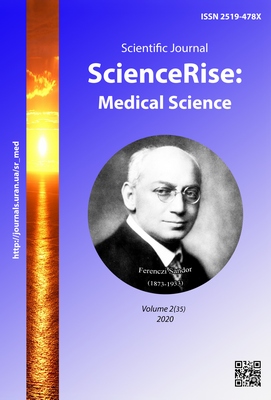Рівень прив’язаності до плоду у жінок із загрозою передчасних пологів на ІІІ триместрі вагітності та психомоторний розвиток дитини першого року життя у світлі взаємодії в системі «мати – дитина»
DOI:
https://doi.org/10.15587/2519-4798.2020.199848Ключові слова:
загроза передчасних пологів, рівень прив’язаності матері до плоду, психомоторний розвиток дитини.Анотація
Мета роботи - вивчення рівня прив’язаності до плоду жінок із загрозою передчасних пологів на III триместрі вагітності та психомоторного розвитку дитини першого року життя.
Матеріали і методи. У дослідження було включено 150 вагітних на III триместрі вагітності (23 – 37 тижнів), та їх чоловіків. Із них основну групу склали 120 жінок з із загрозою передчасних пологів на останньому триместрі вагітності (ОГ). Групу порівняння становили 30 жінок з фізіологічним перебігом вагітності (ГП).
Результати та обговорення. Встановлено, що у жінок ОГ рівень прив’язаності матері до плоду становив 71±1 (порушення прив’язаності) , а у жінок ГП 51±2 (достатній рівень прив’язаності). Оцінка психомоторного розвитку дитини протягом першого року життя довела існування тенденції щодо відставання його показників у дітей матерів ОГ (після другого обстеження ОГК) порівняно з немовлятами жінок ГП та ОГТ протягом усіх періодів спостереження (р<0,05). Така різниця показників психомоторного розвитку спостерігалася вже на третьому обстеженні: рівень розвитку дітей матерів ГП був достовірно вищим, ніж у жінок ОГ. На четвертому обстеженні діти матерів ОГТ (29.0±0.2) продемонстрували кращі показники психомоторного розвитку, ніж немовлята жінок ОГК (27.5±0.3), проте нижчі, ніж у ГП (29.4±0.1). У подальшому рівень психомоторного розвитку дітей ГП та ОГТ практично зрівнявся на відміну від показників дітей ОГК (28.1±0.4), що були нижчими, ніж в інших групах. При досягненні малюками віку одного року найкращий рівень психомоторного розвитку продемонстрували діти матерів ОГТ (29.2±0.3), практично однакові результати були у дітей ГП (29.1±0.3), а показники дітей ОГК були нижчими (28.5±0.2).
Висновки. Cеред негативних факторів, що провокують формування порушення діадичної взаємодії, провідними є психологічна неготовність до материнства та низький рівень прив’язаності до плоду жінок із загрозою передчасних пологів на III триместрі вагітності.
Посилання
- Skrypnikov, A. M., Herasymenko, L. O., Isakov, R. I. (2017). Perynatalna psykholohiia. Kyiv: Vydavnychyi dim Medknyha, 168.
- Di Benedetto, C. (2015). 9 Things Every Woman Should Know About Mental Health During Pregnancy. Available at: https://www.health.com/condition/depression/depression-during-pregnancy
- Buckley, S. J. (2015). Hormonal Physiology of Childbearing: Evidence and Implications for Women, Babies, and Maternity Care. Washington: Childbirth Connection Programs, National Partnership for Women & Families. Available at: https://www.nationalpartnership.org/our-work/resources/health-care/maternity/hormonal-physiology-of-childbearing.pdf
- Van den Heuvel, M. I., Johannes, M. A., Henrichs, J., Van den Bergh, B. R. H. (2015). Maternal mindfulness during pregnancy and infant socio-emotional development and temperament: The mediating role of maternal anxiety. Early Human Development, 91 (2), 103–108. doi: http://doi.org/10.1016/j.earlhumdev.2014.12.003
- Bai, G., Raat, H., Jaddoe, V. W. V., Mautner, E., Korfage, I. J. (2018). Trajectories and predictors of women’s health-related quality of life during pregnancy: A large longitudinal cohort study. PLOS ONE, 13 (4), e0194999. doi: http://doi.org/10.1371/journal.pone.0194999
- Parsa, N., Nor Yaacob, S., Rof Redzuan, M., Parsa, P., Sabour Esmaeili, N. (2014). Parental Attachment, Inter-Parental Conflict and Late Adolescent’s Self-Efficacy. Asian Social Science, 10 (8), 123–131. doi: http://doi.org/10.5539/ass.v10n8p123
- Filippova, G. G. (2005). Psikhologicheskaia gotovnost k materinstvu. Khrestomatiia po perinatalnoi psikhologii: psikhologiia beremennosti, rodov i poslerodovogo perioda. Moscow: URAO, 62–66.
- TSaregradskaia, Zh. V. (2010). Rebenok ot zachatiia do goda. Moscow: AST, Astrel, 288.
- Stein, A., Pearson, R. M., Goodman, S. H., Rapa, E., Rahman, A., McCallum, M. et. al. (2014). Effects of perinatal mental disorders on the fetus and child. The Lancet, 384 (9956), 1800–1819. doi: http://doi.org/10.1016/s0140-6736(14)61277-0
- Dobriakov, I. V. (2012). Perinatalnaia psikhologiia – novyi razdel klinicheskoi (meditsinskoi) psikhologii Meditsinskaia psikhologiia v Rossii, 5 (16). Available at: http://www.mprj.ru/archiv_global/2012_5_16/nomer/nomer27.php
- Slomian, J., Emonts, P., Vigneron, L., Acconcia, A., Glowacz, F., Reginster, J. Y. et. al. (2017). Identifying maternal needs following childbirth: A qualitative study among mothers, fathers and professionals. BMC Pregnancy and Childbirth, 17 (1). doi: http://doi.org/10.1186/s12884-017-1398-1
- Preterm birth (2015). Wold Health Organization (WHO). Available at: http://www.who.int/mediacentre/factsheets/fs363/en/
- Heron, J., O’Connor, T. G., Evans, J., Golding, J., Glover, V. (2004). The course of anxiety and depression through pregnancy and the postpartum in a community sample. Journal of Affective Disorders, 80 (1), 65–73. doi: http://doi.org/10.1016/j.jad.2003.08.004
##submission.downloads##
Опубліковано
Як цитувати
Номер
Розділ
Ліцензія
Авторське право (c) 2020 Natalia Grinko

Ця робота ліцензується відповідно до Creative Commons Attribution 4.0 International License.
Наше видання використовує положення про авторські права Creative Commons CC BY для журналів відкритого доступу.
Автори, які публікуються у цьому журналі, погоджуються з наступними умовами:
1. Автори залишають за собою право на авторство своєї роботи та передають журналу право першої публікації цієї роботи на умовах ліцензії Creative Commons CC BY, котра дозволяє іншим особам вільно розповсюджувати опубліковану роботу з обов'язковим посиланням на авторів оригінальної роботи та першу публікацію роботи у цьому журналі.
2. Автори мають право укладати самостійні додаткові угоди щодо неексклюзивного розповсюдження роботи у тому вигляді, в якому вона була опублікована цим журналом (наприклад, розміщувати роботу в електронному сховищі установи або публікувати у складі монографії), за умови збереження посилання на першу публікацію роботи у цьому журналі.










